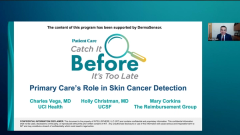
Routine Visits, Real Impact: Where Skin Cancer Checks Fit In
Panelists discuss how visual examination remains the primary method for evaluating suspicious skin lesions in everyday practice, emphasizing clinical judgment, patient-reported changes, and the growing—but still limited—role of artificial intelligence (AI) tools, while underscoring the importance of vigilance, especially in high-risk and underserved populations with limited access to dermatology.
Episodes in this series

In everyday practice, the most common approach to evaluating suspicious skin lesions remains a visual examination. Many providers begin with their clinical judgment, using observation and patient history to decide whether further action is needed. For about a third of clinicians, this includes an immediate referral to a dermatologist, while others might rely on additional tools such as minor surgical procedures or biopsy within their own practice. Some practices are beginning to incorporate advanced technologies, including AI-assisted devices, though their use is not yet widespread. Providers strive to strike a balance between being cautious without overburdening dermatology resources or alarming patients unnecessarily.
A recurring theme is the importance of listening closely when patients express concern about changes in their skin. Since the most significant risk factor for skin cancer is lesion change, clinicians are encouraged to take these reports seriously. However, they also recognize that not all changes are pathological—trauma or irritation may be involved. Practical tips, such as advising patients to cover a lesion with a bandage for a week to see if inflammation resolves, can help determine if a biopsy is warranted. Importantly, when providers are not immediately concerned, they’re advised to avoid saying a lesion is "nothing," instead encouraging follow-up if it evolves.
Clinical vigilance is especially critical for high-risk populations: those with fair skin, many moles, a personal or family history of skin cancer, or immunosuppression. People with significant sun exposure, regardless of skin tone, are also vulnerable. In underserved or rural areas, primary care providers often fill gaps left by limited specialist access, reinforcing the need for education and confidence in skin assessments. Integrating skin checks into routine exams—particularly for high-risk individuals—can aid early detection without overextending the primary care visit. In the absence of time or training for full-body exams, even a quick scan during a heart or lung check can make a difference.
Newsletter
Enhance your clinical practice with the Patient Care newsletter, offering the latest evidence-based guidelines, diagnostic insights, and treatment strategies for primary care physicians.













































































































































































































































































